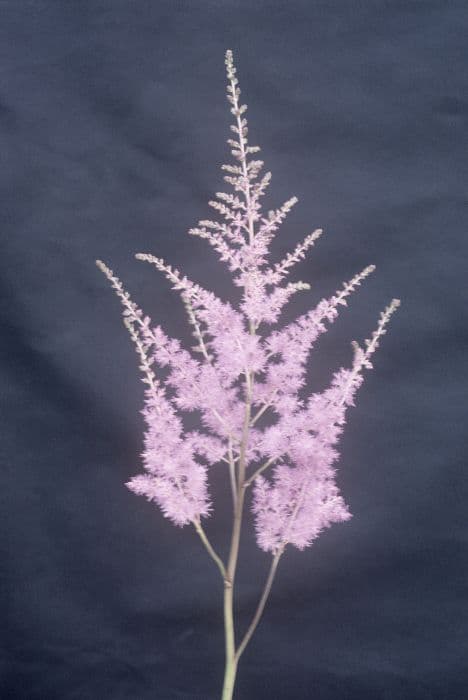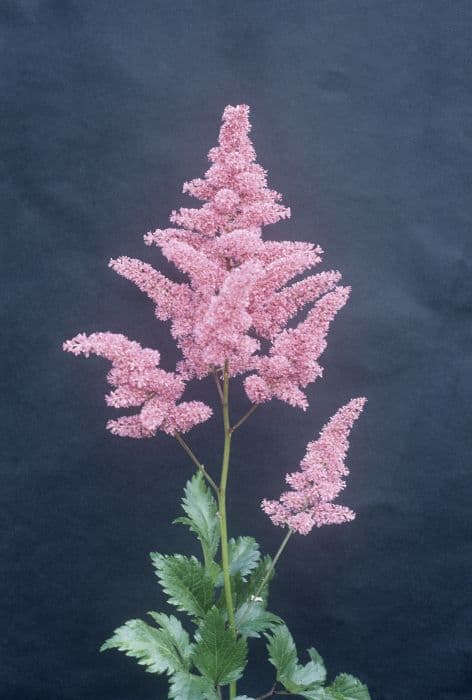Coral Bells Heuchera 'Magic Wand'

ABOUT
Heuchera 'Magic Wand' stands out with its vibrant foliage and flowering spires. The plant is known for its rounded leaves which are often a mix of colors, sometimes deep green with a hint of silver or purple tones that add a touch of magic to garden spaces. The leaves may have a distinct veining, providing added texture and visual interest. When it blooms, Heuchera 'Magic Wand' produces delicate-looking flower stalks, which are adorned with clusters of small, bell-shaped flowers ranging in color from creamy white to soft pink. These ethereal flowering spires seem to rise like wands from the colorful foliage, giving the plant a whimsical appearance. This variety of Heuchera tends to have robust and healthy foliage that can change colors with the seasons, further adding to its appeal.
About this plant
 Names
NamesFamily
Saxifragaceae.
Synonyms
Coral Bells, Alumroot.
Common names
Heuchera 'Magic Wand'.
 Toxicity
ToxicityTo humans
Heuchera 'Magic Wand,' commonly known as Coral Bells, is not typically considered toxic to humans. Therefore, ingestion of this plant is not expected to cause significant symptoms of poisoning.
To pets
Coral Bells are not known to be toxic to pets. If ingested by dogs, cats, or other household animals, they are not likely to experience symptoms of poisoning, making Coral Bells a pet-friendly option for gardens and homes.
 Characteristics
CharacteristicsLife cycle
Perennials
Foliage type
Semi-deciduous
Color of leaves
Varies
Flower color
Varies
Height
1-2 feet (30-60 cm)
Spread
1-2 feet (30-60 cm)
Plant type
Herb
Hardiness zones
4-9
Native area
North America
Benefits
 General Benefits
General Benefits- Attractive Foliage: Heuchera 'Magic Wand', commonly known as Coral Bells, has colorful, often multi-hued leaves that add visual interest to the garden.
- Long Blooming Flowers: Coral Bells produce delicate flowering spikes that can add a touch of elegance and color throughout the blooming season.
- Easy Maintenance: This plant is known for being low-maintenance, requiring minimal care once established.
- Drought Tolerance: Once established, Coral Bells are quite drought-tolerant, making them suitable for xeriscaping or gardens with less frequent watering.
- Pest and Disease Resistance: Heuchera 'Magic Wand' generally resists many pests and diseases, helping to reduce the need for chemical treatments.
- Attracts Pollinators: The flowers of Coral Bells are known to attract hummingbirds and butterflies, beneficial for pollination.
- Versatility: They can be used in a variety of garden settings, including borders, containers, and as ground covers.
- Seasonal Interest: With evergreen or semi-evergreen varieties, Heuchera 'Magic Wand' provides year-round interest, depending on the climate.
- Shade Tolerance: Coral Bells can thrive in a range of light conditions, including shaded areas where many other plants struggle.
- Deer and Rabbit Resistance: The foliage is typically not favored by deer or rabbits, which can be beneficial in gardens prone to these visitors.
 Medical Properties
Medical PropertiesThis plant is not used for medical purposes.
 Air-purifying Qualities
Air-purifying QualitiesThis plant is not specifically known for air purifying qualities.
 Other Uses
Other Uses- Photography Backgrounds: Heuchera 'Magic Wand', with its attractive foliage, provides an excellent backdrop for photographers looking to capture images of insects and other small creatures on a natural canvas.
- Artistic Inspiration: The unique colors and textures of the Heuchera 'Magic Wand' leaves can inspire artists and designers, making it a great live model for botanical drawings and design work.
- Education and Demonstration: Heuchera 'Magic Wand' can be used in schools or botanical gardens to demonstrate the variety of leaf colors, textures, and patterns that exist within the world of plants.
- Miniature Gardening: Due to its compact size, this variety is perfect for creating fairy gardens or miniature landscapes that require small, colorful foliage.
- Biorhythmic Research: The circadian behavior of Heuchera 'Magic Wand', such as leaf movements or color changes, can be observed and studied for understanding plant biorhythms.
- Frost Tolerance Testing: As Heuchera 'Magic Wand' is frost-tolerant, it can be used in experimental gardens to test and demonstrate how certain plants can survive in cold conditions.
- Soil Quality Indicator: The health and color of Heuchera 'Magic Wand' can serve as an indicator of soil quality, which can be useful for gardeners monitoring their soil health.
- Dye Production: While not common, the leaves of Heuchera 'Magic Wand' can potentially be used to produce natural dyes for fabric or craft purposes.
- Culinary Presentation: The vibrant leaves can be used to add a pop of color when plating dishes, although they are not typically used for consumption.
- Garden Theme Inspiration: This plant can be a key component in creating garden themes such as ‘wizardry’ or ‘magic,’ due to its enchanting name and appearance.
Interesting Facts
 Feng Shui
Feng ShuiHeuchera, commonly known as Coral Bells, is not traditionally associated with Feng Shui practices.
 Zodiac Sign Compitability
Zodiac Sign CompitabilityCoral Bells is not used in astrology practice.
 Plant Symbolism
Plant Symbolism- Durability: The Heuchera, also known as Coral Bells, is a perennial plant, symbolizing longevity and the ability to withstand different conditions.
- Versatility: Coral Bells come in various colors and can adapt to different light situations, symbolizing flexibility and adaptability in life.
- Attraction: With its bell-shaped flowers, the Coral Bells plant symbolizes allure and the idea of drawing in what one desires, much like its capacity to attract hummingbirds.
- Protection: The Heuchera is known for its hardy nature; it can represent protection and a sense of safety.
 Water
WaterCoral Bells should be watered thoroughly, ensuring the soil is moist but not waterlogged. Generally, they need about 1 inch of water per week, whether from rainfall or manual watering. During the growing season, check the soil moisture regularly and water when the top inch of soil feels dry to the touch. In hotter, drier seasons, you may need to water once or twice a week, while in cooler, wetter periods, watering frequency should be reduced. Avoid overhead watering to prevent disease, and instead, use a soaker hose or drip irrigation to deliver water directly to the root zone.
 Light
LightCoral Bells thrive in a spot with partial shade, particularly during the hottest part of the afternoon. They can tolerate morning sun but prefer protection from intense direct sunlight. Ideal lighting conditions include dappled sunlight under the canopy of trees or a location that receives filtered light throughout the day. They can also do well in full shade, although their foliage color might not be as vibrant.
 Temperature
TemperatureCoral Bells prefer a temperature range of 60 to 70 degrees Fahrenheit but can survive in temperatures as low as 0 degrees Fahrenheit and as high as 80 degrees Fahrenheit. To ensure the plant thrives, avoid placing it in conditions that consistently exceed these temperature extremes. The ideal temperature range will encourage healthy growth and vibrant foliage.
 Pruning
PruningPrune Coral Bells to remove any dead or damaged leaves and to maintain plant shape. This is best done in early spring or later in the fall after flowering has finished. Regular pruning helps to encourage new growth and improve air circulation, which can reduce the likelihood of disease. Additionally, deadheading spent flowers can promote a tidier appearance and sometimes encourage additional blooms.
 Cleaning
CleaningAs needed
 Soil
SoilCoral Bells (Heuchera 'Magic Wand') thrive in well-draining soil rich in organic matter with a pH range of 6.0 to 7.0. A suitable mix would include peat, compost, perlite, and a small amount of coarse sand to aid drainage. Regularly amending the soil with compost will keep it fertile and suitable for these plants.
 Repotting
RepottingCoral Bells are not typically fast-growing and therefore do not need frequent repotting. They should be repotted every 2 to 3 years or when signs of crowding occur. Doing so in spring allows them to establish in the growing season.
 Humidity & Misting
Humidity & MistingCoral Bells prefer moderate humidity but are quite adaptable. They do well in average home humidity levels, though ensuring good air circulation around the plant can prevent issues related to high humidity such as fungal diseases.
 Suitable locations
Suitable locationsIndoor
Place Coral Bells in bright, indirect light with well-draining soil.
Outdoor
Plant in partial shade, well-draining soil, and mulch in winter.
Hardiness zone
4-9 USDA
 Life cycle
Life cycleHeuchera 'Magic Wand', commonly known as Coral Bells, begins its life as a seed, which germinates in favourable conditions of moisture and temperature. The seedlings emerge and develop into rosettes of foliage, with the characteristic lobed and often colorful leaves. As the plant matures, it develops a sturdy root system, often rhizomatous, which allows it to overwinter and resprout yearly. Coral Bells produce flowering stems, known as scapes, that rise above the foliage and bloom with small, bell-shaped flowers, attracting pollinators during the spring to early summer months. After pollination, these flowers produce seeds, which can be dispersed by wind or wildlife, perpetuating the cycle. In optimal conditions, Coral Bells can live for several years, with the foliage remaining evergreen or semi-evergreen in milder climates.
 Propogation
PropogationPropogation time
Spring to Summer
The Heuchera 'Magic Wand', commonly known as Coral Bells, can typically be propagated through division, which is the most popular method of propagation for this perennial. The best time for dividing Coral Bells is in the spring or early fall when the plant is not in full bloom, allowing the divided plants time to establish their root system before extreme heat or cold. To propagate by division, carefully dig up the entire plant, making sure to keep as much of the root system intact as possible. Gently separate the plant into smaller sections, each with a portion of the roots and several shoots. Replant the divisions at the same depth they were previously grown, giving each new plant about 18 to 24 inches (approximately 45 to 60 centimeters) of space to grow. Water the newly planted divisions well to help establish them, but avoid overwatering, as Coral Bells prefer well-drained soil.









